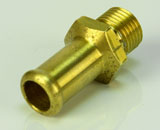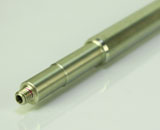
When the screw machine product was created 100 years ago, it’s original purpose was to make screws for a variety of different products. However, while the name has remained the same, the technology behind a screw machine product has evolved throughout the years to meet the needs of modern turned components. CNC (or computer numerical control) turned products is the automation of machine tools that operate via computer-programmed commands, as opposed to mechanically automated machines such as a screw machine. So, what are the benefits of each?
Screw Machine Products
 A screw machine product is a class of automatic lathes for small to medium sized parts. The name “screw machine” is considered to be a tad misleading, as they don’t actually create screws anymore or screw anything into place. Instead, they spin on a rotating lathe, which essentially shaves metal down to a desired size. A screw machine functions with a disc cam, which is a rotating piece used to transform rotary motion into linear motion or vice versa using either a single spindle or multiple. Because a screw machine operates with close spindle collets, deflected debris is reduced to minimal or none at all.
A screw machine product is a class of automatic lathes for small to medium sized parts. The name “screw machine” is considered to be a tad misleading, as they don’t actually create screws anymore or screw anything into place. Instead, they spin on a rotating lathe, which essentially shaves metal down to a desired size. A screw machine functions with a disc cam, which is a rotating piece used to transform rotary motion into linear motion or vice versa using either a single spindle or multiple. Because a screw machine operates with close spindle collets, deflected debris is reduced to minimal or none at all.
Screw Machine Manufacturing Capabilities
Screw machines are used for bar work majority of the time. The entire bar stock is passed through and turns with the spindle, and then is separated from the part and fed forward, making the screw machine ready for the next part. Screw machines are more time efficient than CNC turned products due to the tightness of the collets, work-piece and tooling.
CNC Turned Products
 The first CNC machines were created in the 1940s and 1950s, modifying existing tools and implementing motors into the design. CNC products essentially function the same way as screw machine products, but instead of being operated by cams, they are mainly controlled by computers. Having transformed a great deal throughout the years, CNC turned products now are equipped to feature more sets of tooling than screw machine products, which allows the machine to perform multiple operations on the part in a shorter amount of time.
The first CNC machines were created in the 1940s and 1950s, modifying existing tools and implementing motors into the design. CNC products essentially function the same way as screw machine products, but instead of being operated by cams, they are mainly controlled by computers. Having transformed a great deal throughout the years, CNC turned products now are equipped to feature more sets of tooling than screw machine products, which allows the machine to perform multiple operations on the part in a shorter amount of time.
CNC Turning Manufacturing Capabilities
CNC turned products are known for being the most precise machine in it’s class. According to Thomasnet.com, a CNC machine can rotate a part at up to 10,000RPM at an accuracy level of 0.0002 to 0.0005 inches. Because of the machine’s extreme precision, it is used for a variety of operations that involve a complex series of movements, including laser cutting, welding, ultrasonic welding, and flame and plasma cutting.
Do you need a part created but aren’t sure what would be the best process - CNC turning or screw machines? Ask us! We’ll be happy to help you figure it out.
